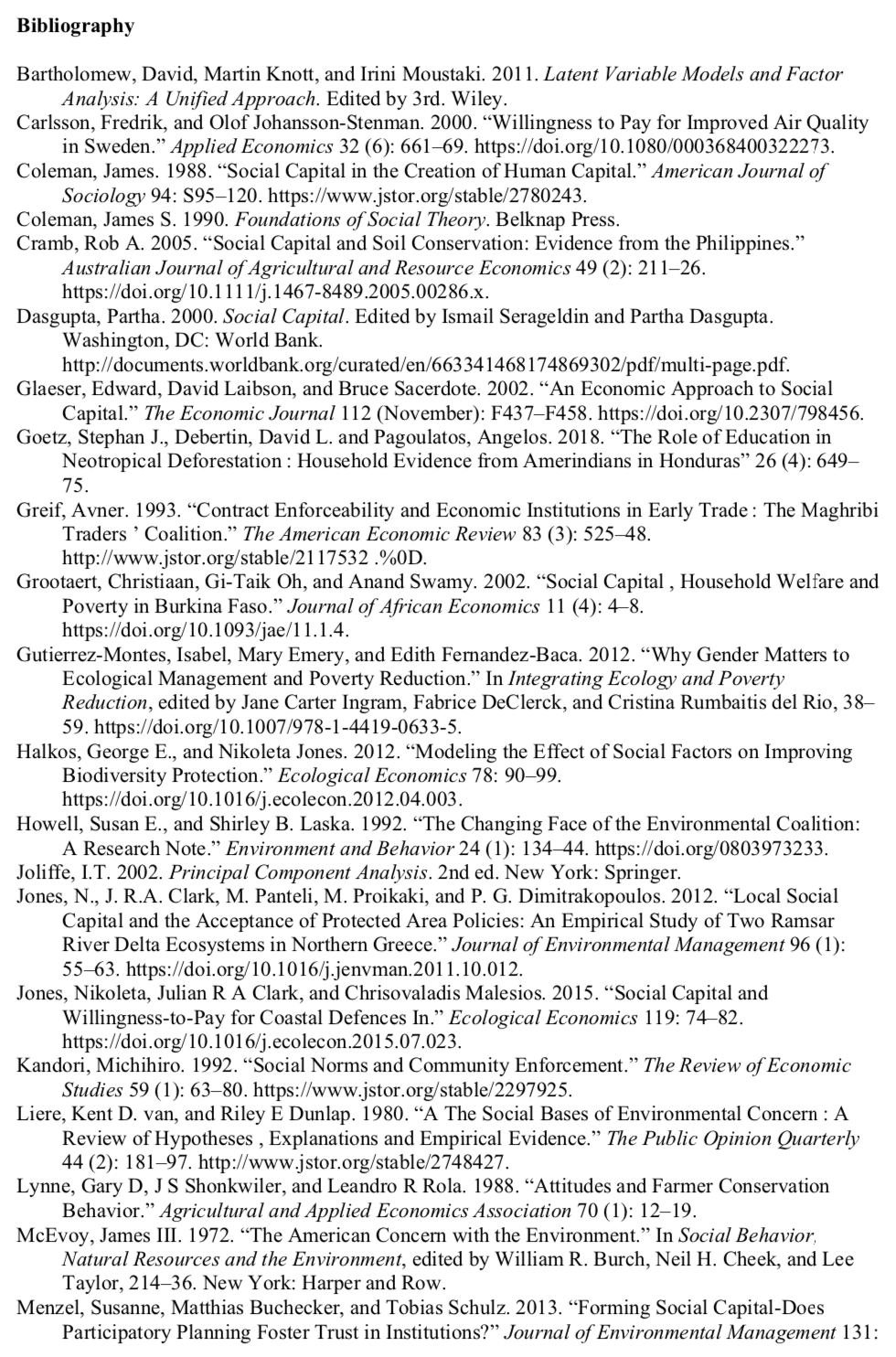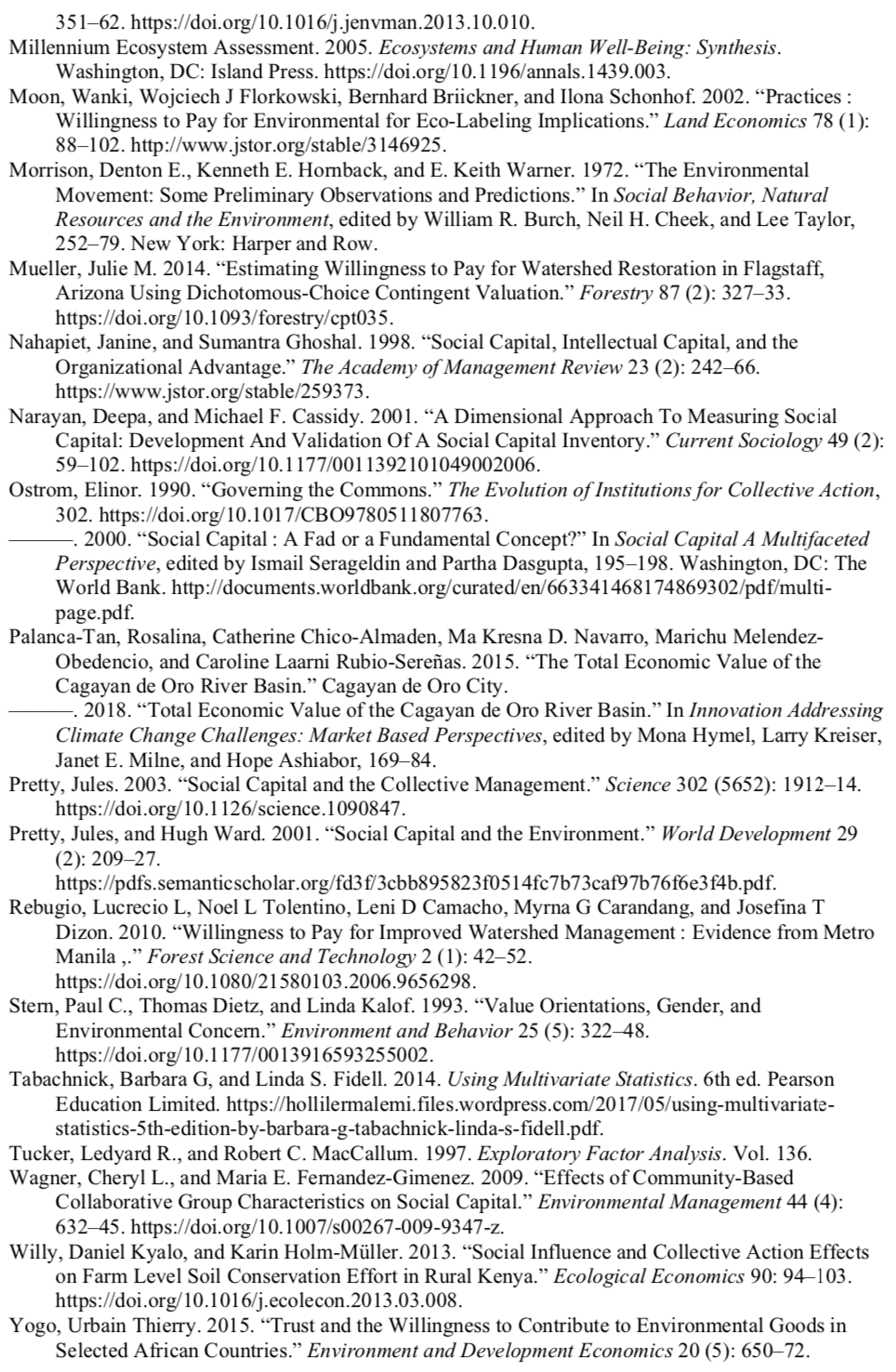Social Capital Influences Preservation of Cagayan de Oro Riverbasin (CDORB): A Household Level Analysis in the Communities of Cagayan de Oro City, Philippines
Paper by Ma Kresna Navarro-Mansueto of Winter School 2019
Social Capital Influences Preservation of Cagayan de Oro Riverbasin (CDORB):
A Household Level Analysis in the Communities of Cagayan de Oro City, Philippines
By
Ma Kresna Navarro-Mansueto
University of the Philippines-Cebu
Philippines
ABSTRACT
Millennium Ecosystem Assessment (2005) reports that humans are unsustainably using 60% of ecosystem services for human activities and economic development. While these are common goods, replenishment of the quality and quantity of these natural resources takes time. Natural resources are exposed to overconsumption but are nonetheless excluded in the accounting of economic performance. Due to these complexities of the relationship between humans and the environment, institutions are important. Available literature on social capital shows how repeated social interaction averts free riding conducts or punish commitment violators (Greif 1993). This study explores preservation strategy for Cagayan de Oro Riverbasin (CDORB) by harnessing the social capital of the households of Cagayan de Oro City (CDO). CDORB is one of the 18 major river basins in the country with a total area of 137,384 hectares. The ecosystem services of CDORB is shared by four provinces of Northern Mindanao and Lanao del Sur, a province of Autonomous Region in Muslim Mindanao (ARMM). Hence, this study aims to investigate the role of social capital in the rehabilitation and preservation of Cagayan de Oro River Basin (CDORB). Research questions include: 1. What are forms of “collective” assets that are structurally suited for ecosystem preservation in Cagayan de Oro City?; 2. Can social capital be created where it is missing, and can it lead to positive environmental outcomes? (Pretty and Ward 2001); and 3. Can households’ socio-economic factors influence willingness to participate in the preservation of CDORB? To obtain answers on these research questions, the researcher make use of the household survey and key informant interviews from previous study of (Palanca-Tan et al. 2018). Willingness to Pay is derived using the Contingent Valuation Method. Social Capital is an index of three components: membership to groups, civic participation; and trust. The study adopts the theoretical model of Yogo (2015). Findings indicate that social capital index is statistically related with the coefficients of age, gender, and monthly household income. However, explanatory variables have low predictive capacity with willingness to pay for CDORB rehabilitation and preservation.
Keyword: Cagayan de Oro River Basin, Sustainability, Preservation, Willingness to Pay, Social Capital
1. Introduction and Review of Related Literature
This study aims to investigate the role of social capital in the rehabilitation and preservation of Cagayan de Oro River Basin (CDORB). Cagayan de Oro River Basin (CDORB) is one of the 18 major river basins in the country with a total area of 137,384 hectares. The ecosystem services of CDORB is shared by four (4) provinces of Northern Mindanao and Lanao del Sur, a province of Autonomous Region in Muslim Mindanao (ARMM).
The residue of the various upland activities in Bukidnon descends into the seas of Macajalar Bay in Misamis Oriental heavily loaded with sediments, domestic sewerage and mining by-products, which during immense raining and flooding create sedimentation plume at the mouth of Cagayan de Oro River. This heavy siltation caused by denuded watersheds affect the quality of water, productivity (catch) of the fisher folks and recreation activities around the CDO River and Macajalar Bay (Palanca-Tan et al., 2015). It threatens the endemic and economically viable fish “pigok” (Terapon jarbua) (Roa-Quiaoit, 2011). The recent experience from catastrophic damage caused by Typhoon Washi in 2011 reminded local government units of various local government units, especially Cagayan de Oro City which was heavily affected by the typhoon, to address the issues and problems in CDORB (See CDORB Management and Development Master Plan).
The city local government, academe, religious sectors and civil society organizations made a series of interventions to restore the state of the River Basin. This was formalized in November 16, 2010, Cagayan de Oro Riverbasin Management Council (CDORBMC) was formed as a multi-sectoral group of Government Agencies (GAs), Local Government Units (LGUs), Non-Government Organizations (NGOs), private sectors, religious groups, People’s Organization/Indigenous People (PO/IP), Security and Academe that converged together to protect, preserve, rehabilitate and manage the watersheds, rivers, and forests of the Cagayan de Oro riverbasin. The CDORBMC seeks to improve the quality of life of the stakeholders by upholding and implementing appropriate interventions to enhance better utilization of natural resources and to boost biodiversity along watersheds and rivers. It also encouraged all other stakeholders to become part of the formulation of management plans and strategies for the riverbasin (Cagayan de Oro Riverbasin Management Council).
In May 2014, Payment for Ecosystem (PES) project was began in Mt Kalatungan, Bukidnon aimed at rehabilitating Cagayan de Oro River Basin. This incentive-based mechanism pays “sellers” of ecosystem services to those “buyers” of these intangible products. Miarayon-Lapol-Lirongan-Tinaytayan-Tribal Association (MILALITTRA) served as seller of this project while different sectors like business, cooperatives, academic institutions, religious organizations and households of Cagayan de Oro City – are buyers of the ecosystem services.
In the early months of 2015, International Union for Conservation of Nature (IUCN) funded the project, entitled: Total Economic Value of the Cagayan de Oro River Basin (Palanca-Tan et al. 2015). In Summer 2015, the team headed by Rosalina Palanca-Tan, started the household data gathering after series of consultations with local government units and held focus group discussions with few local households. The study aims to estimate the use and non-use values of the CDORB base from the household communities of Cagayan de Oro City.
Environment connects everyone because human beings are dependent on the ecosystem services. However, the “commons” aspects of natural resources expose itself from overconsumption but are undervalued. More so, what people do in one place affects people elsewhere. The externality property of the environment enters directly into the activities and livelihoods of all people in the society. The crucial role of the environment to the existence of the human race requires an institution that can monitor defectors from cooperative action to preserve, conserve and manage these resources.
Cooperation arises from social relationships rooted from mutually agreed benefits and obligations (Dasgupta 2000). However, studies claim that successful cooperative groups are based on reputation and community enforcement (J. Coleman 1988; Ostrom 1990; Kandori 1992; Dasgupta 2000). Joining collective action groups or social organizations involves evaluating the cost and benefits of participating. If the benefits from individual activity (i.e cost of collective action) are higher than the cost, then an aspirant may opt to work things by himself. As Ostrom (2000, 178) puts it: ”To create social capital in a self-conscious manner, an individual must spend time and energy working with one another to craft institutions.” Even Coleman (1990) emphasizes that benefits from any forms of social capital are not universal, what may be beneficial to a group may be useless or harmful to others. To benefit from any form of social capital, everyone should take an active role in public discourse, participation in planning, and willingness to pay for better environmental services.
Pretty and Ward (2001) enumerate some benefits from social organizations. They have estimated that 408,000-478,000 new social groups mostly in developing countries, roughly an estimate of 8.2-14.3 million of people are engaged in watershed/catchment management, irrigation management, micro-finance delivery, forest management, integrated pest management, and farmers’ research groups (Pretty and Ward 2001, 214). Participation of people is important in environmental planning and policy-making (Jones et al. 2012; Menzel, Buchecker, and Schulz 2013).
Menzel, Buchecker, and Schulz (2013) observe that the degree of participation and quality of participatory processes substantially affect the results and outcomes of the project, and formation of institutional trust. Participatory processes are concepts that contribute to the understanding of how trust develop overtime. This include stakeholder influence, perceived appreciation of engagements, transparency and fairness in the decision-making, and expected outcomes. Trust in institutions arise from high level general trust; it is also affecting the quality of participatory processes. In contrast, the level of stakeholder influences negatively to related changes in trust of institutions; and affecting “good” participatory process.
Willy and Holm-Müller (2013), examine two econometric models to assess the effect of participation in collective action initiatives, neighborhood social influence, and other covariates on the soil conservation efforts among smallholder farmers in Lake Naivasha basin, Kenya. In the first model, it estimates collective action initiatives using binary probit regression while in the second model, it estimates soil conservation efforts using ordered logit model.
Willingness to pay of environmental quality is another mechanism indicating inclination towards better environmental quality. In the cross-country analysis, the ordered logit estimates signify that the composite trust index is positive and statistically associated to the willingness to pay for environmental protection in selected African countries (Yogo 2015). For other covariates, U-shaped relationship between age and WTP, no gender effect to WTP, positive effect of education to WTP, positive income effect to WTP for the 10th decile and negative effect to WTP for bottom income distribution starting from 4th decile, and effect of religion is only significant for Muslims. Furthermore, IV tests were used to resolve causality.
This current study is part of the rehabilitation and preservation plan of CDORB using the survey questionnaire of Palanca-Tan et al. (2015) but focus on the relationship between social capital and willingness to pay for rehabilitation and preservation of CDORB. It answers the following questions: a) what are forms of “collective” assets that are structurally suited for ecosystem rehabilitation and preservation in Cagayan de Oro City?; 2. Can social capital be created where it is missing, and can it lead to positive environmental outcomes? (Pretty and Ward 2001); and 3. Can households’ socio-economic factors influence willingness to participate in the preservation of CDORB?. The rest of the paper is organized into four (4) sections: theoretical and conceptual frameworks, methodology, results and discussion; and conclusions and policy implications.
2. Theoretical and Conceptual Frameworks
The theoretical framework of this study is anchored on the study of Yogo (2015) where environmental quality is derived from the optimal consumption model. The economic agent is given the choice to either purchase more material goods at the expense of lower environmental quality or less material goods but better environmental quality. However, environmental quality is dependent on the cooperation of all citizens. Cooperation arises from social relationships rooted in mutually agreed benefits and obligations (Dasgupta 2000). As Ostrom (2000, 178) puts it: ”To create social capital in a self-conscious manner, an individual must spend time and energy working with one another to craft institutions.”
Let x be the quality of the material good and e, a measurable quality of the environment. This could either be a tradeoff of composite consumer goods and environmental quality. The consumer choice behavior can be represented by a Cobb-Douglas utility function:
![]()
Eq. (1)
where ![]() ,
,![]() , refers to the utility elasticity of material goods and
, refers to the utility elasticity of material goods and ![]() is a residual factor explaining the choice of the individual. It further assumes that the material good x is purchased at price
is a residual factor explaining the choice of the individual. It further assumes that the material good x is purchased at price ![]() , and environmental quality is purchased at price
, and environmental quality is purchased at price![]() . As environmental quality depends on cooperation, Yogo (2015) assumed two types of behavior. First, consuming more of environmental good, sacrificing consumption goods, without cooperation with other fellow citizens will not result to any significant effect on environmental quality. Benefits from environmental quality accrues only if all citizens act cooperatively. Second, if everyone cooperates, the individual expects a gain
. As environmental quality depends on cooperation, Yogo (2015) assumed two types of behavior. First, consuming more of environmental good, sacrificing consumption goods, without cooperation with other fellow citizens will not result to any significant effect on environmental quality. Benefits from environmental quality accrues only if all citizens act cooperatively. Second, if everyone cooperates, the individual expects a gain ![]() stemming from better environmental quality. For instance, better health could lead to higher productivity and wages. Hence, let
stemming from better environmental quality. For instance, better health could lead to higher productivity and wages. Hence, let ![]() be the probability that the consumer assigns to the event where other citizens will cooperate. The maximization problem is the following:
be the probability that the consumer assigns to the event where other citizens will cooperate. The maximization problem is the following:
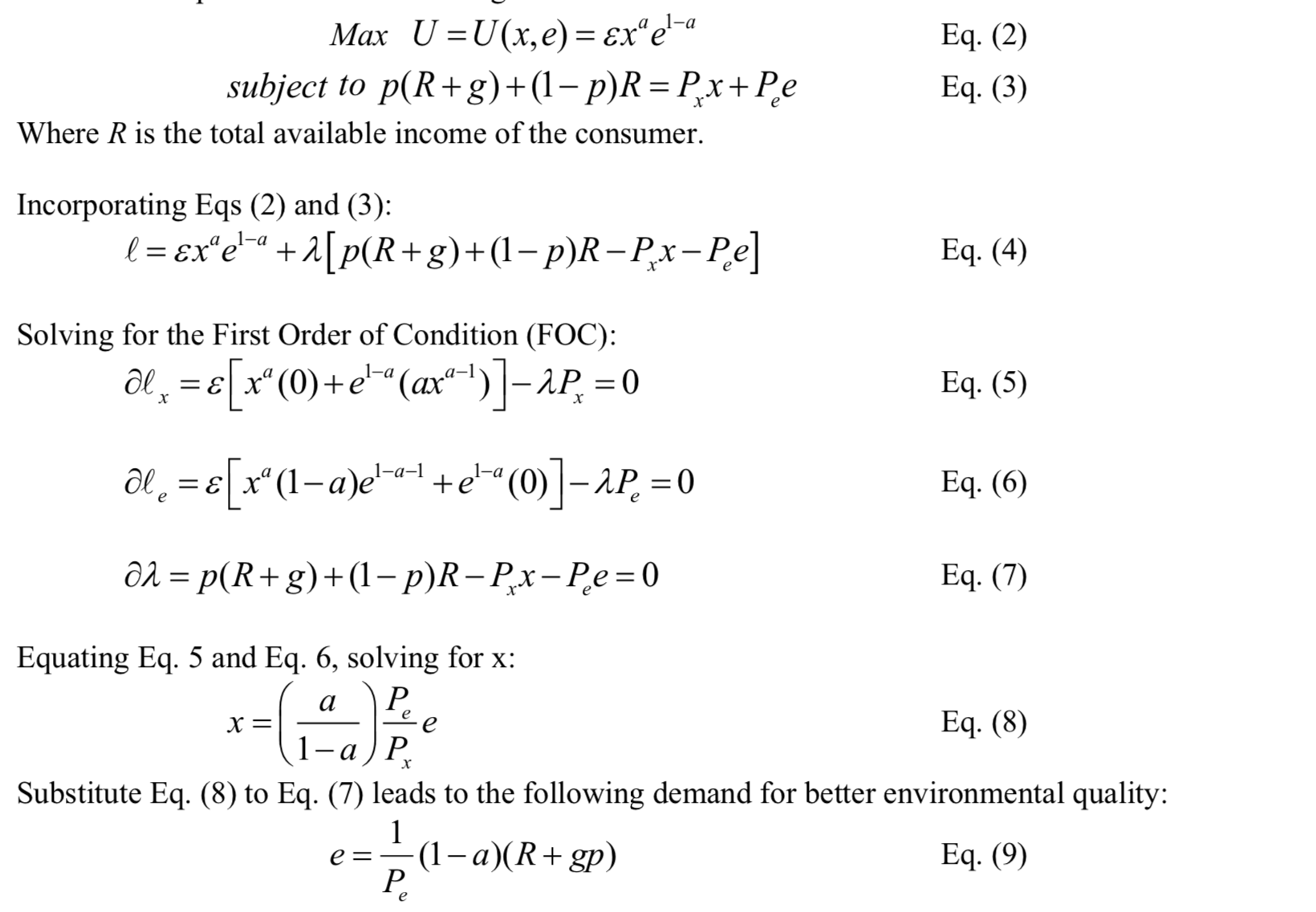
Equation (9) delivers four main predictions: (1) the demand for better environmental quality is positively associated with the level of income (R), (2) the higher the expected gain (g), the higher is the demand for better environment, but g is affected by citizen’s cooperation (p) (i.e forms of social capital like norms, trust, social participation; and reciprocity), (3) the higher the price of environmental good (Pe), the lower is the demand for better environmental quality, and (4) the demand for better environmental quality is an increasing function of the utility elasticity of the environmental good (a). This elasticity actually reflects the preference for environmental good. This preference may vary across individuals, depending on socioeconomic characteristics, such as age, sex, education and religion.
Given the relationship above, Figure 1 shows the links between dependent and independent variables.
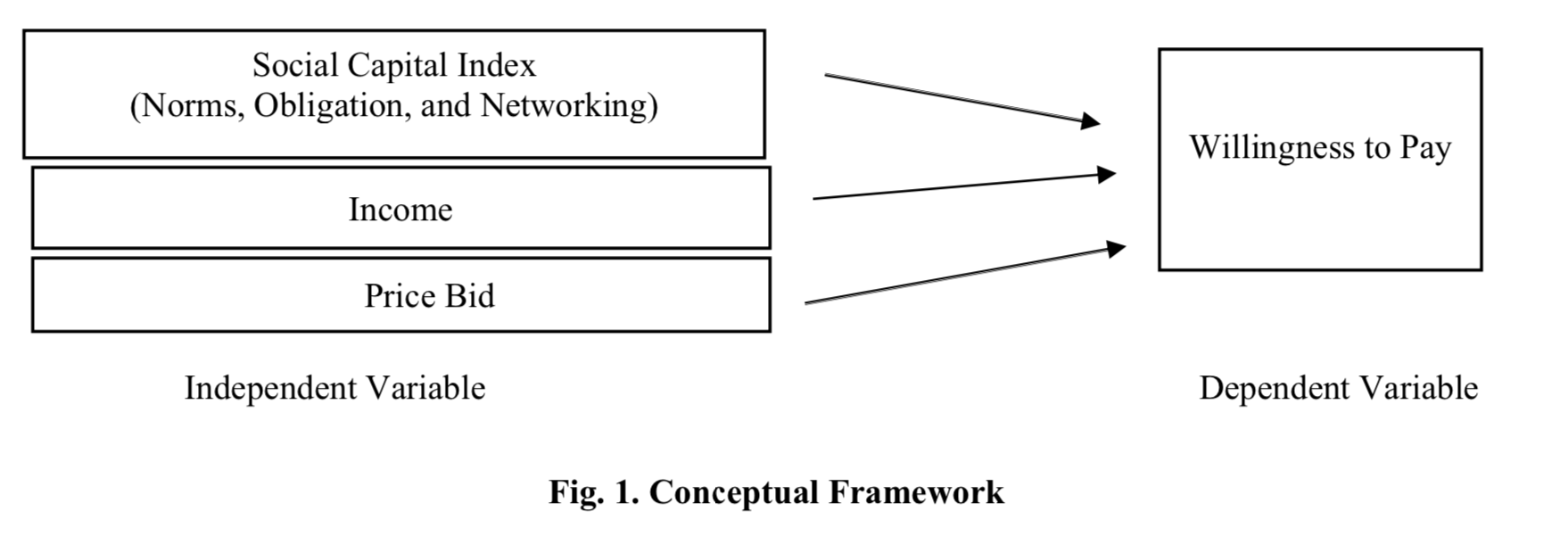
3. Data Sources, Hypothesis and Analysis Methods
3.1 Survey and Data Sources
The Philippines’ Cagayan de Oro River Basin (CDORB) is one of the 18 major river basins in the country. It spreads to eight major rivers within seven municipalities: Talakag, Baungon, Libona and Pangantucan of Bukidnon; Iligan City of Lanao del Norte; Municipality of Bubong of Lanao del Sur; and Cagayan de Oro City, which is composed of 122 barangays (see figure 2.1). It covers 1,521 sq km of protected mountain ranges at the peak to the water that flows in Cagayan de Oro River and drops into Macajalar Bay.
In the early month of 2015, International Union for Conservation of Nature (IUCN) funded the project, entitled: Total Economic Value of the Cagayan de Oro River Basin (Palanca-Tan et al. 2015). Summer 2015, the team headed by Rosalina Palanca-Tan, started the household data gathering after series of consultations with local government units and focus group discussions with few local households. The project has administered guided questionnaires to households in the downstream communities of Cagayan de Oro City, consisting of 40 poblacion and 41 other barangays. It garners responses from 963 household heads.
The methodology of the WTP will not be discussed in this paper since it is extensively discussed in their book chapter ((Palanca-Tan et al. 2018). However, it will briefly discuss the process. This current study is part of the dissemination plan and will use of the information from the survey questionnaire. The researcher’s addition to the dissemination plan, is a construction of social capital index.
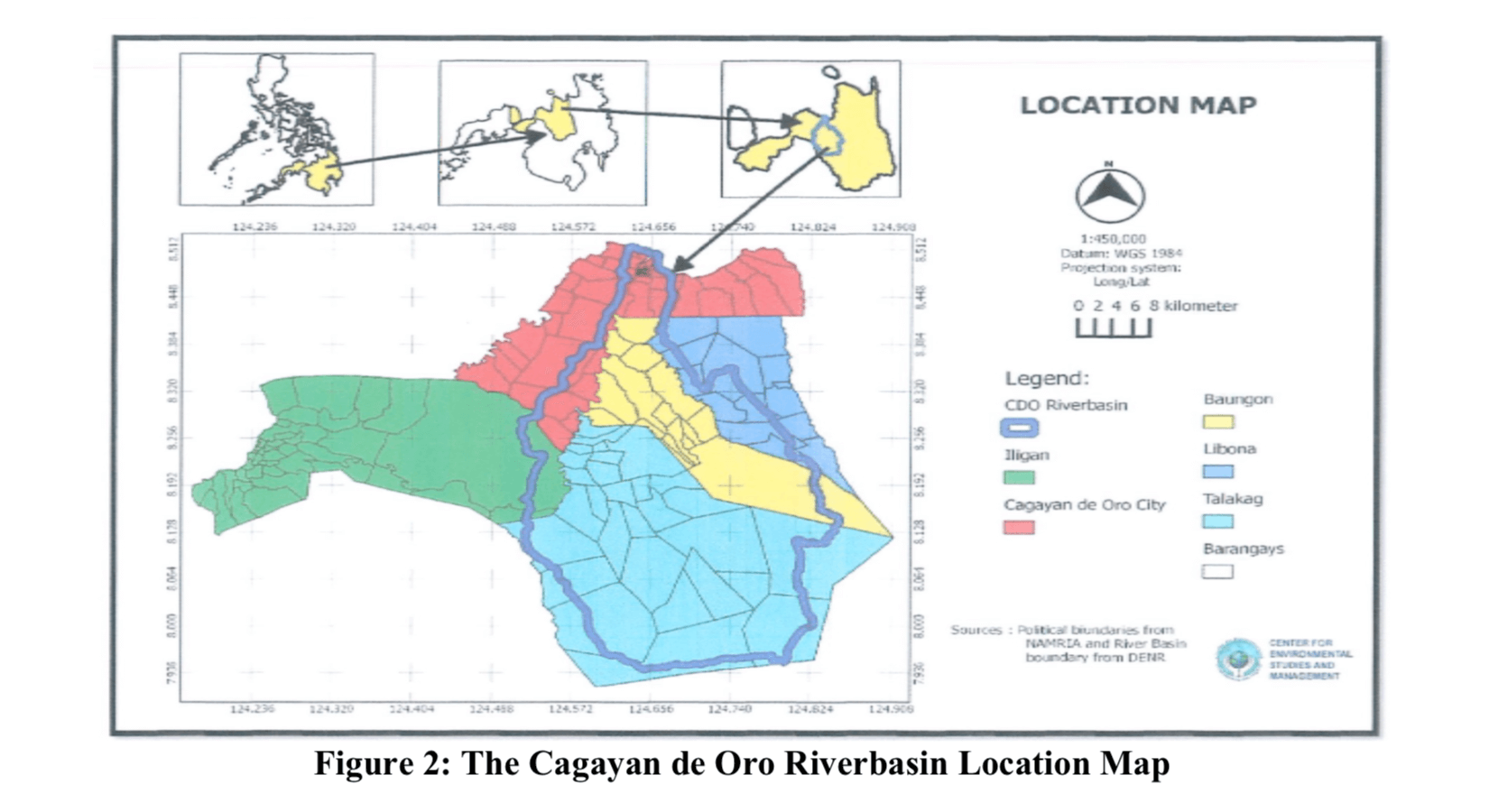
3.2 Hypothesis
As reviewed from literature, social capital influences collective participation in managing natural resources (Ostrom 1990; Pretty 2003). In this study, participation in managing natural resources is through the respondent’s willingness to pay (WTP) in order to rehabilitate and preserve the Cagayan de Oro River Basin (CDORB). There have been few studies examining the link of social capital towards an individual’s decision to monetarily contribute for environmental management. The empirical model specification in this study is, therefore, largely guided by previous research dealings with conservation practices on the tangible uses of natural resources, environmental policies, and consumer attitudes toward general environmental issues. Economic and demographic variables, consumer’s perception about environmental risk, and consumer’s attitudes towards environmental issues and practices have been shown to influence environmental protection and conservation issues (Lynne, Shonkwiler, and Rola 1988; Moon et al. 2002; Halkos and Jones 2012; Willy and Holm-Müller 2013; Nikoleta Jones, Clark, and Malesios 2015)
This paper investigates the correlation between WTP for better environmental quality. Findings of the past studies indicate varying signs of the relationship between indicators of social capital and willingness to pay. Norms and trust positively related to WTP (Halkos and Jones 2012; Jones, Clark, and Malesios 2015; Yogo 2015), and reciprocity and social networks negatively influence WTP (Halkos and Jones 2012; Nikoleta Jones, Clark, and Malesios 2015). Table 1 enumerates the expected sign of all explanatory variables in the study per model.
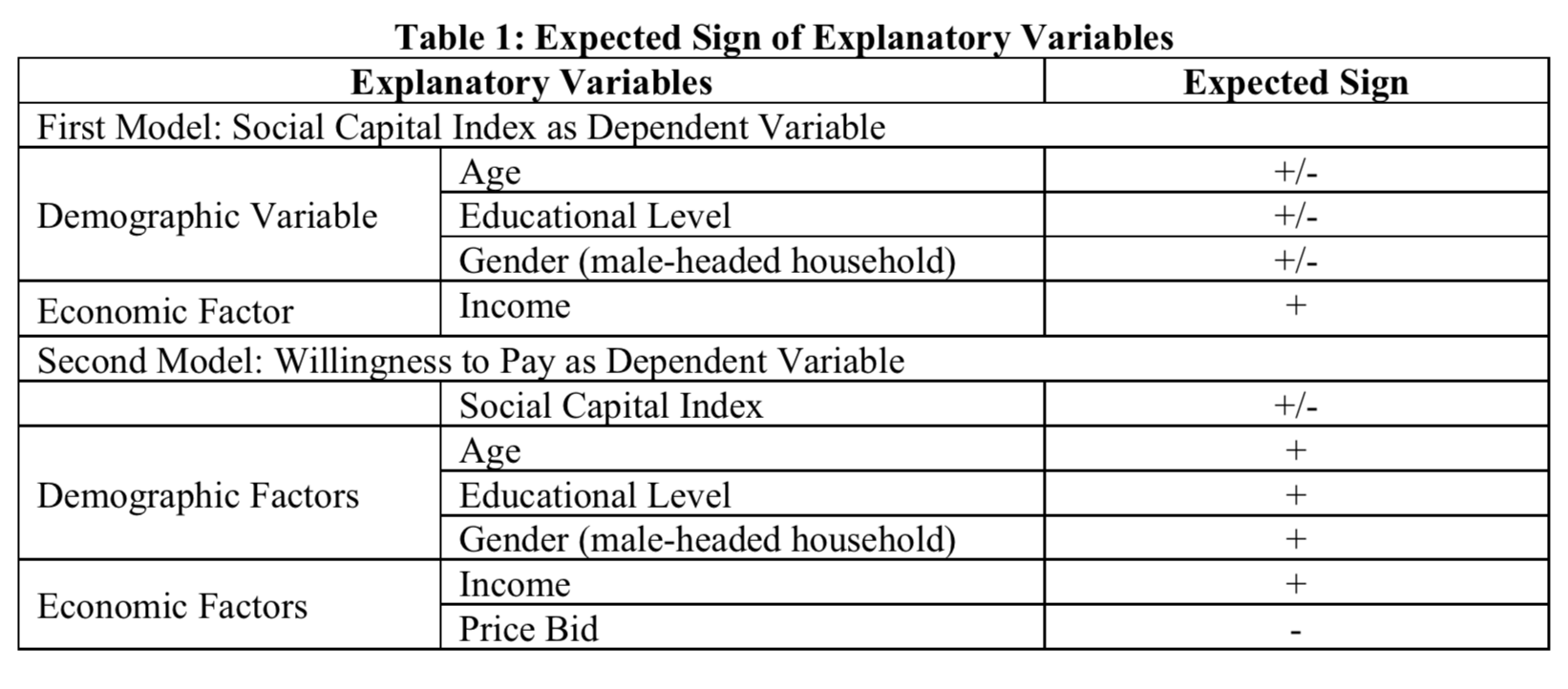
3.3 Methodology
Principal component analysis (PCA) and factor analysis (FA) are widely used approaches to create indexes. Both approaches are data reduction techniques that produce linear combination of observed variables, where each linear combination is a factor (or component for principal component analysis). The produced components from PCA and factors of FA “summarize patterns of correlations in observed correlation matrix and can be used, with varying degrees of success, to reproduce the observed variables”(Tabachnick and Fidell 2014, 661). However, they are mathematically, theoretically, and statistically different (Joliffe 2002; Bartholomew, Knott, and Moustaki 2011; Yong and Pearce 2013; Tabachnick and Fidell 2014). Exploratory factor analysis is a technique for testing hypothesis or building new metrics while confirmatory factor analysis is a technique replicating created metrics (Yong and Pearce 2013). This study initially plans to adopt exploratory factor analysis.
There are five requirements to perform factor analysis: sample size, absence of missing data and outliers, univariate and multivariate normality within the data, linear relationship among pairs of variables, and absence of multicolinearity and singularity (Tucker and MacCallum 1997; Yong and Pearce 2013; Tabachnick and Fidell 2014). Performing the above requirements detect that data are not suitable for FA. Hence, the study adopts the weighted average procedure to compute for the social capital index.
Social capital index ( ![]() ) is a weighted average of variables representing three dimensions of social capital: social norms, social obligations and social network. Each dimension is composed of variables (in statement form) describing specific forms of social capital, see Table 2. Eq 10 is the household’s social capital index:
) is a weighted average of variables representing three dimensions of social capital: social norms, social obligations and social network. Each dimension is composed of variables (in statement form) describing specific forms of social capital, see Table 2. Eq 10 is the household’s social capital index:

Where SNi is a percent of respondent’s “agree” responses to the total number of statements regarding “social norms” for household i, SOi is a percent of respondent’s “agree” responses to the total number of statements regarding “social obligation” for household i, and Ni is a percent of respondent’s “agree” responses to the total number of statements regarding “social network” for household i.
Table 2: Dimensions of Social Capital and Scoring procedure
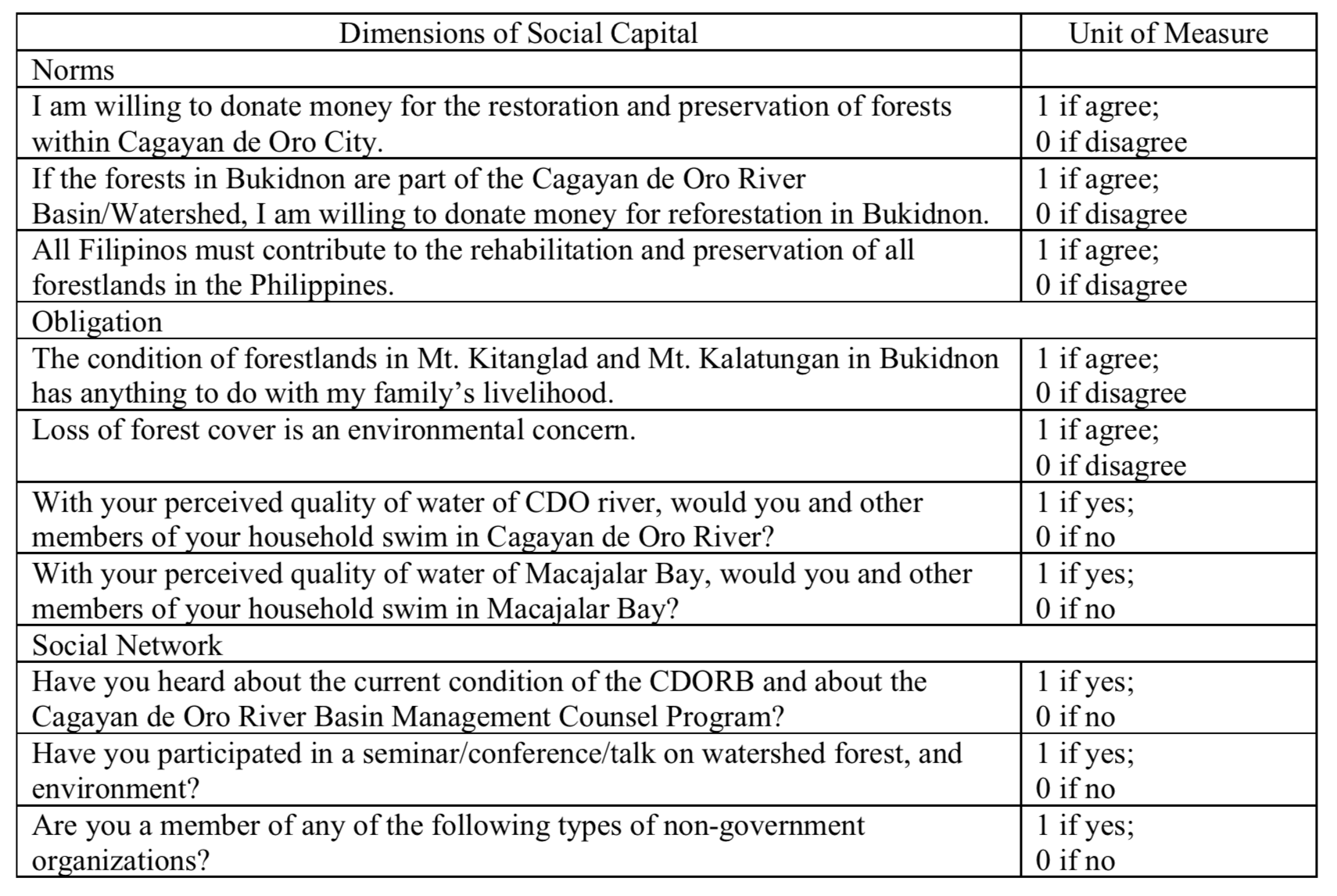
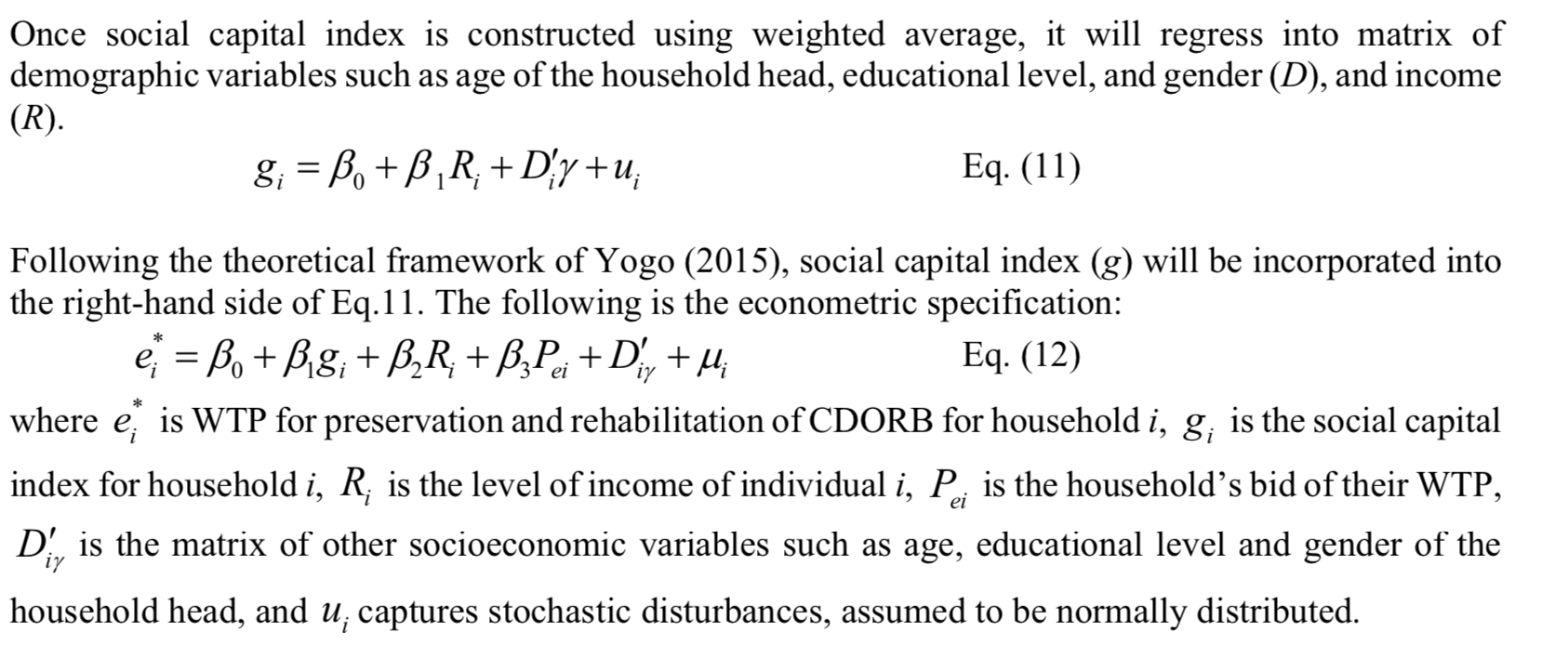
4. Results and Discussions
Demographic and economic profile of the households are shown in tables 3 and 4. Some variables gathered in the survey which provide background information for this study, but not used in the regression, are mentioned below.
The average age of household heads is 47 years old and completed some level of secondary education. More than two-thirds of the household heads are female. However, male-headed households have low education attainment. On the average, they have not finished primary school.
Table 3: Demographic Profile of the Household Heads

Despite that households are headed by males, Palanca-Tan (2015a) mentioned that in the Philippines and in some Asian countries, even the non-income earning housewives are entrusted with making budget decisions for the household, and thus qualify for the household head definition. More than half (51.61%) of the respondents have monthly household income of no more than P10,000. In 2015, when the survey was made, the Philippine Statistics Office (PSA) reported that the average monthly family income in Northern Mindanao was P22,345, and the annual per capita poverty threshold in the region was P221,000 (PSA, 2017). This means that the average households in the survey lived below the annual per capita poverty threshold. Considering each household’s property, more than two-thirds of the respondents lived in their own house and lot comprising with no less than 2 rooms and a toilet. Respondents also have considerable number of appliances.
The main water supplier of 77% of the households is the Cagayan de Oro Water District (COWD). Of these, 75% have private water connections and 25% are shared. The average number of households sharing one COWD water line is three (3) households. Other water companies present in Cagayan de Oro (CDO) cater to very specific small areas in the city such as some areas in barangays (villages) not easily reached by COWD due to elevation or some subdivisions served by a water system developed by their real estate company. All together, they service only 4% of our sample (40 out of 963 households). There is a substantial proportion of households (60 or 6.2% of responding households) that relied mainly on public taps that provide water free of charge (with a minimal monthly contribution or occasional contribution for repair, in some cases). Another 3% of households relied on public artesian wells which also provide free water. Households that relied mainly on their own deep well is roughly 3%.
Majority of the respondents think that the CDO River and Macajalar Bay are already polluted, to some extent. While majority of households think that Macajalar Bay is still suitable for swimming, only 22% think this is the case for CDO River. Household sewage, mine and quarry tailings, solid and animal wastes are perceived to be the major causes of pollution in the CDO River. In the case of Macajalar Bay, majority of the households perceived that sewage from homes, wastewater from factories and solid wastes are the main sources of pollution. Other pollution sources mentioned by the respondents are hospital wastes, people residing near creeks, increasing population, logs and mountain trash that flow downstream during flooding, and animal carcasses.
When respondents are asked about their willingness and capability to pay for additional percent (%) of their water bill as contribution to CDORB watershed rehabilitation and preservation, more than half of the respondents are in favor of paying at least 20% on top of their monthly water bill, with a maximum of 50%.
Table 4: Economic Profile of the Households


Roughly five of every ten respondents agree mostly on two statements describing social norms. Also, almost three out of ten respondents agree on one statement describing social obligations. Furthermore, roughly six out of 10 respondents have no social network.
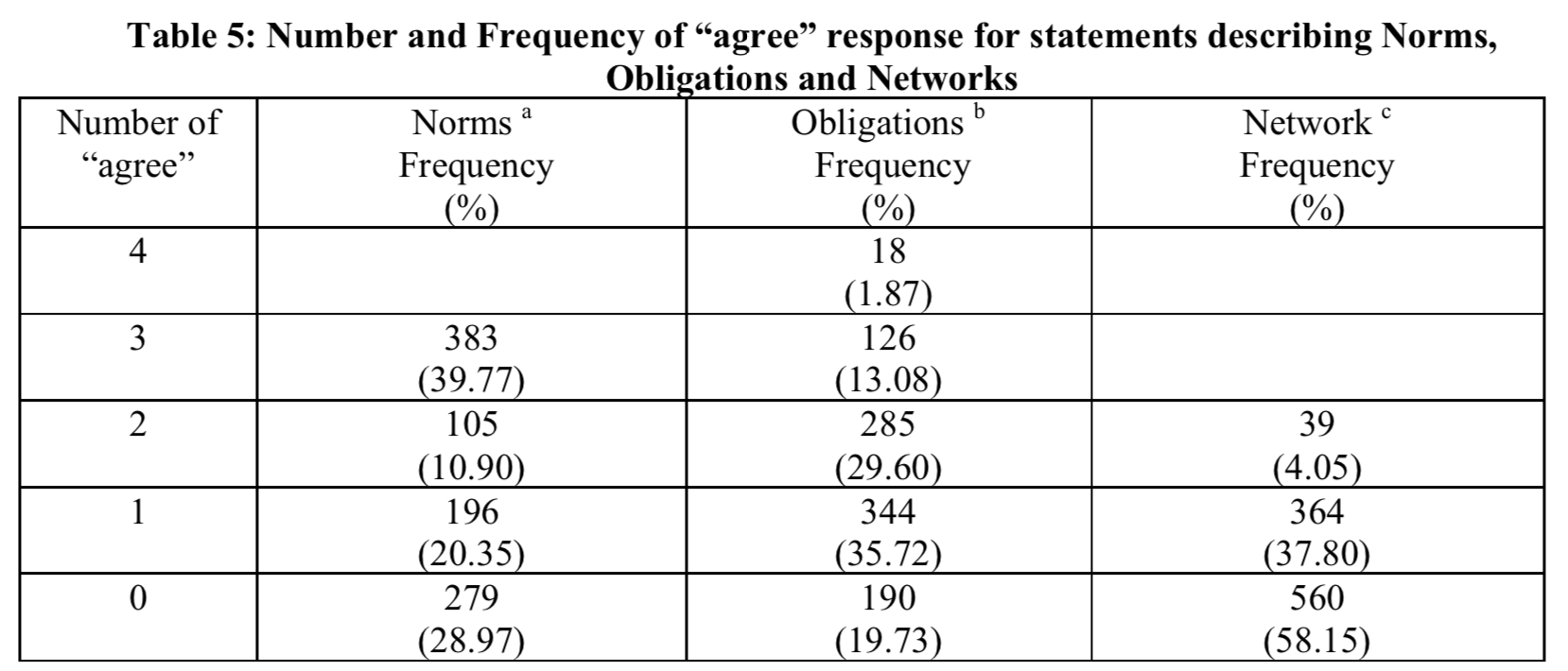
Note:
a Three statements describing social norms.
b Four statements describing social obligations.
c Three statements describing social network.
Following the weighted mean computation for social capital index, the average social capital index is .349. While the maximum social capital index is .8, some respondents have zero social capital index. Analysis should be taken with caution, however. This does not describe respondents with zero social capital, instead about poor social capital, in the context of this study. When majority of respondents agree on statements describing social norms and social obligations, considerable number of respondents have no social networks outside their family circle.
For instance, four years since the creation of Cagayan de Oro Riverbasin Management Council (CDORBMC), only 15% of the respondents have heard about the Council and its activities. Information about the council was obtained mainly through television and radio, less on social relationships from organizations or groups.
Watershed and CDORB scenario are presented to the respondents to measure their willingness to pay for rehabilitation and preservation to CDORB. The WTP question is based on the guidelines of the Contingent Valuation Method (CVM). A specific question is asked from the household head: “Would you vote in favor of the implementation of the CDORB rehabilitation and preservation program and be willing and capable to pay an additional __% of your water bill as your contribution to CDORB watershed rehabilitation and preservation?”
When it accounts responses from all respondents, the monthly contribution for CDORB rehabilitation and preservation is on the average P508.019 ($9.65) per month. This value includes respondents who access water free of charge, either someone pays for them or part of their lodging fee. If it excludes respondents with no water bill, monthly contribution for CDORB rehabilitation and preservation is on the average of P560.39 ($10.65) per month.

Regression model shows relationship between social capital index and specific explanatory variable, holding other variables constant. As shown in Table 7, this excludes 10 respondents who choose not to divulge their monthly household income. The model has a poor power for explanatory variables to explain the variability of the social capital index, this is shown in a 2% adjusted R-squared. However, the F-ratio indicates that the joint contribution of explanatory variable has effect on social capital index. This is also shown in the high t-statistic of some coefficients of the independent variables such as age, gender, and monthly household income. Analysis should be taken with caution, however. Also, coefficients of the independent variables follow the hypothesized signs.
Age has negative relationship with social capital. Past studies indicate age effect has an inverted u-shaped association with social capital. This indicates that at an age cohort, social capital increases dramatically, but eventually declines with age. (Glaeser, Laibson, and Sacerdote 2002; Cramb 2005).
Studies on gender differences in relation to social capital point to males have more social interactions than females. McEvoy (1972) argues that the active participation of males in civic and political discussions open opportunities for men to be more well-informed. Some culture gives high preference for men to access formal education than females, hence, increases men’s social relationships.
Positive relationship of household family income and social capital support previous several studies (Narayan and Cassidy 2001; Glaeser, Laibson, and Sacerdote 2002; Grootaert, Oh, and Swamy 2002). In the case Narayan and Cassidy (2001), social capital affects total consumption expenditures per person in the household (as proxy for household income). One standard-deviation increase in the village social capital index is associated with 50% increase expenditures per person in each household in the village.
Coleman (1988) has viewed social interaction as a factor to human capital formation. Aside from the learning and experience obtained from socialization is the implicit benefit of education. Earlier study of Nahapiet and Ghoshal (1998) indicates that cognitive development of a child can be based from relational dimensions of social capital which are widely linked to organizational advantage. In the current study, the coefficient of educational level has positive relationship with social capital but not statistically significant.
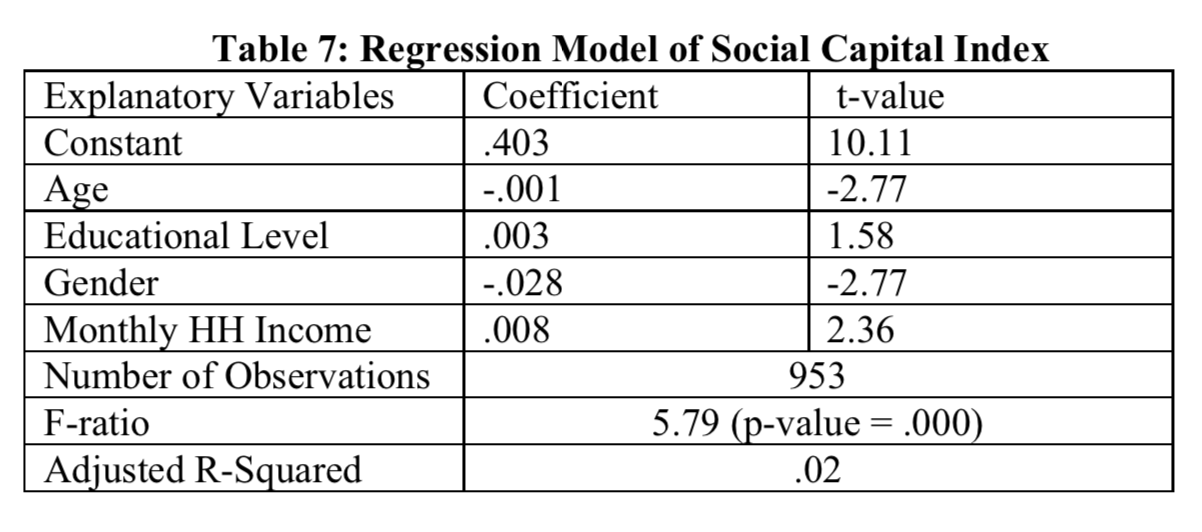
Willingness to pay (WTP) has two models. One, model includes all observations while another model excludes 10 observations with “no answers” of monthly household income and 90 observations with “zero” WTP. However, both models have negative adjusted R-squared. Tabachnick and Fidell (2014) explain that negative adjusted r-squared shall be reported and interpreted as being zero or all explanatory variables cannot explain the variability of the dependent variables. In this current study, social capital index, price bid and household monthly income cannot explain the variability of the willingness to pay for rehabilitation and preservation of CDORB. One plausible explanation is that the predictors are too many for a very small sample size. Initial sample size is reduced due to “zero” and “no answer” responses.
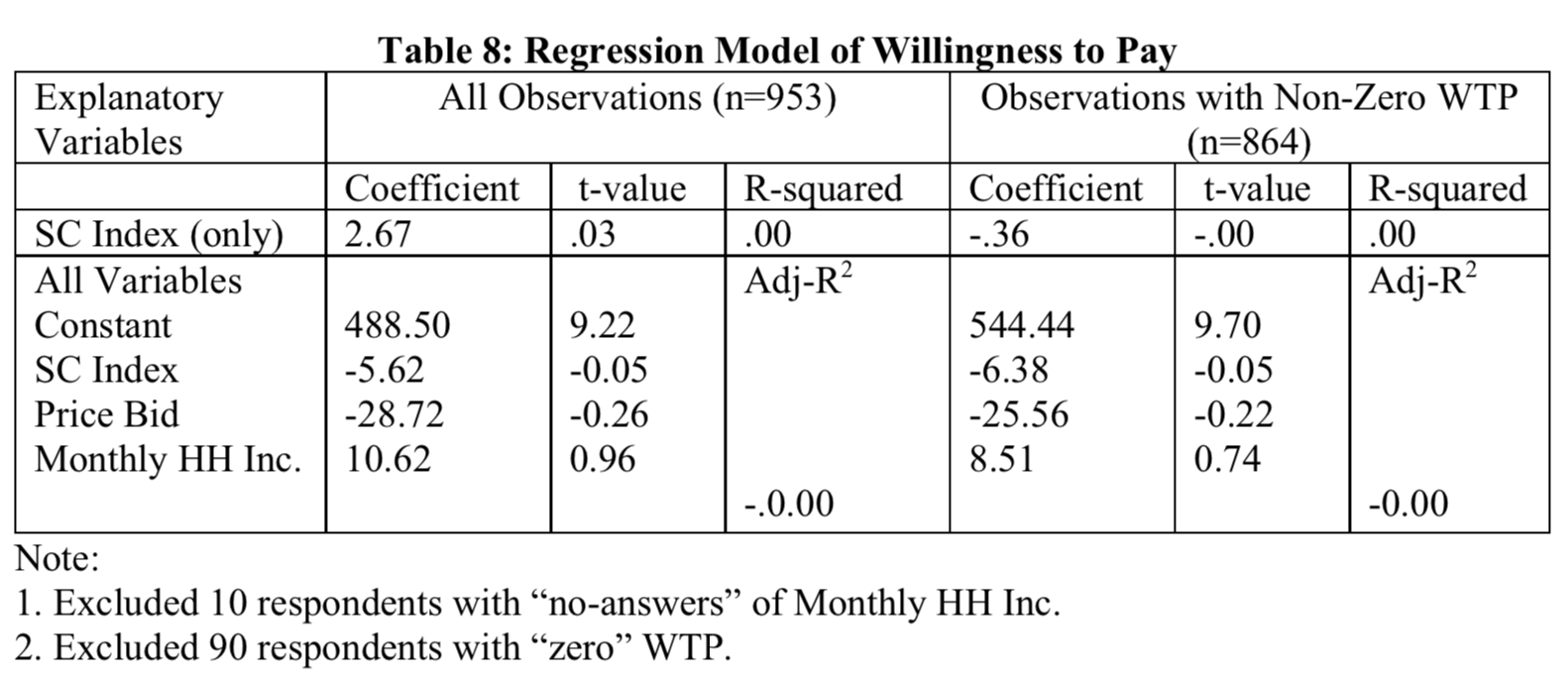
To increase understanding and awareness about WTP and environmental management, the next section discusses findings of past studies from various authors.
Findings of the past studies indicate varying signs of the relationship between indicators of social capital and willingness to pay. Norms and trust positively related to WTP (Halkos and Jones 2012; Jones, Clark, and Malesios 2015; Yogo 2015), and reciprocity and social networks negatively influence WTP (Halkos and Jones 2012; Nikoleta Jones, Clark, and Malesios 2015).
Studies on demographic variables and participation in natural resource management show that age, and educational level positively influence participation in natural environment conservation (Cramb 2005; Willy and Holm-Müller 2013; Goetz, Stephan J., Debertin, David L. and Pagoulatos 2018). Education is observed to be the best predictor of environmental attitudes, as information is likely to reach and be retained by the educated (Howell and Laska 1992), and education levels have been linked to greater concern for the environment and greater likelihood of participation in activities related to environmental management (van Liere and Dunlap 1980; Moon et al. 2002). However, some studies support the hypothesis that younger persons are more active in managing natural resources for one possible reason that older people will not live longer to reap the benefits of preserving resources (van Liere and Dunlap 1980; Carlsson and Johansson-Stenman 2000; Moon et al. 2002).
Gender differences in environmentalism linked to socialization, values, and nature of work and labor (Stern, Dietz, and Kalof 1993; Gutierrez-Montes, Emery, and Fernandez-Baca 2012). McEvoy (1972) argues that the active participation of males in civic and political discussions open opportunities for men to be more well-informed and concerned about environmental issues than women. Recent meta-review of Zelezny, Chua, and Aldrich (2000) covering years 1988 to 1998 found in 13 studies about gender and environment, nine of which link women’s participation in environmental activities than men. Gutierrez-Montes, Emery, and Fernandez-Baca (2012) report evidences showing that the nature of work and labor given to women have set them to be more directly interacting with the natural environment and more directly affected by environmental issues. These arguments result to ambiguous relationship between gender and environment.
Income positively affect WTP in environmental attributes (Moon et al. 2002; Rebugio et al. 2010; Mueller 2014). Higher income would mean not having to spend only for consumer goods but also for other forms of investment such as better environmental attributes. Furthermore, as Morrison, Hornback, and Warner (1972) observe low-income earners are less aware of the environment because they are already living in poor conditions.
Price bid is expected to have a negative effect on the WTP. This can be explained using the law of demand for environmental quality.
5. Conclusions and Policy Implications
This section answers the three research questions which guide the process and flow of this paper. To reiterate: what are forms of “collective” assets that are structurally suited for ecosystem preservation in Cagayan de Oro City?, can social capital be created where it is missing, and can it lead to positive environmental outcomes? (Pretty and Ward 2001), and can households’ socio-economic factors influence willingness to participate in the preservation of CDORB?
There are many forms of “collective” assets, however, this study highlights social norms, social obligations and social networks. Based from the findings, households of Cagayan de Oro City have low social networks outside their family circle. Households are closely knit within the immediate family members but dense social relations with others or poor association with groups like religious organizations, environmental groups, cooperatives and the like. Perhaps some are members of these organizations and groups but their group’s thrust is not about environmental management for CDORB. It could also be a result of poor dissemination about the status of the ecosystem of CDORB and poor campaign for CDORB management.
The creation of Cagayan de Oro River Basin Management Council (CDORBMC), project on the Payment for Ecosystem (PES), and initiatives from different sectors of the academe, businesses, religious organizations and non-government units may help the formation of social capital. The knowledge from these various group and the policy-making roles of the local government units create a concrete scientific-based policy.
Findings of the study indicate that demographic and economic profile of the household heads’ influence formation of social capital. However, these variables have poor predictive capacity to relate it to willingness to pay for CDORB rehabilitation and preservation.
Policy implications are summarized into three. One, this study serves as a scholarly exercise on the growing literature on the influence of social capital in managing common pool resources (Ostrom 1990; Pretty 2003). It is a first study to be done in Cagayan de Oro City which will link social capital and household head decision to pay for the rehabilitation and preservation of CDORB. It examines the households in Cagayan de Oro City’s ability to manage common-pool resources like CDORB. Two, the findings of this study open opportunities to incorporate social dimension in the development of local policies affecting the environment and household welfare. It shows the benefits of localized social organizations that are structurally suited for natural resource management and protection. Three, this study serves as a medium to increase awareness about CDORB and watershed preservation. Promoting environmental awareness would hopefully develop environmental stewardship. It helps increase options toward sustainable practices without compromising other people’s right to experience the various benefits provided by the environment.
